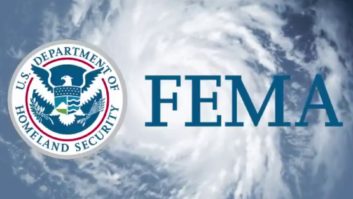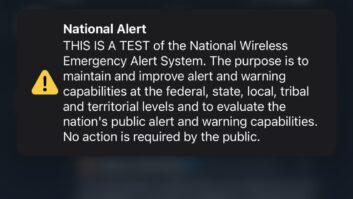FEMA’s Integrated Public Alert & Warning System Program Management Office is targeting late 2015 for another national EAS test, Radio World has learned. In order to accomplish that goal, certain things must happen first, according to sources.
Phase I of the march to another national test has occurred; that was bench testing of the transmission, encoding and decoding of a Common Alerting Protocol-EAS message with a National Protocol Test header at IPAWS’s Lab along the Patuxent River in southern Md.
Phase II involves sending a CAP-EAS message with an NPT event code through IPAWS OPEN in a closed test in West Virginia. FEMA IPAWS conducted such tests in Alaska before the previous national test in 2011.
The NPT event code is key as part of the commission’s open rulemaking on EAS. An advisory committee comprised of alerting experts recommended the FCC adopt event code “NPT” for National Periodic Test, to enable automatic generation of text for national level tests. This recommendation is included in the NPRM the agency is taking comments until Aug. 14 (04-296.)
FEMA IPAWS personnel met recently with several officials from West Virginia emergency management officials to discuss a plan to direct an IPAWS test to that state. FEMA proposed to send a CAP-EAS message with an NPT event code through IPAWS OPEN in what would be Phase II of the IPAWS national test, according to sources. The test is tentatively slated for Sept. 17.
One of the officials in the meeting was West Virginia Broadcast Association Executive Director Michele Crist. She tells RW engineers at some 140 radio and TV stations combined will take part; FEMA, with the support of the WVBA, is asking West Virginia stations to manually set their EAS devices to immediately broadcast an NPT alert sent statewide. FEMA has contacted the EAS device manufacturers to develop device unique configuration instructions and plans to pass these instructions onto station representatives.
But otherwise, the test won’t be that much different from a regular test. A briefing for station engineers with West Virginia emergency management officials and FEMA is set for Aug. 11 in Charleston to discuss the test plan, Crist said.
Stations would report back to the WVBA after the test, she said in an interview, to note if they were able to receive and re-transmit the alert along the daisy chain.
Sources said FEMA’s NPT would be structured similar to a normal required monthly test with an attention signal and a brief announcement beginning with, “This is a test. This station is conducting a test…” To the public, it will sound like a normal EAS test.
The cellular and cable industries are involved in the effort as well; the goal is said to be developing a regularly scheduled national testing routine as recommended by a national test working group of the FCC’s Communications Security, Reliability and Interoperability Council, an advisory group.












